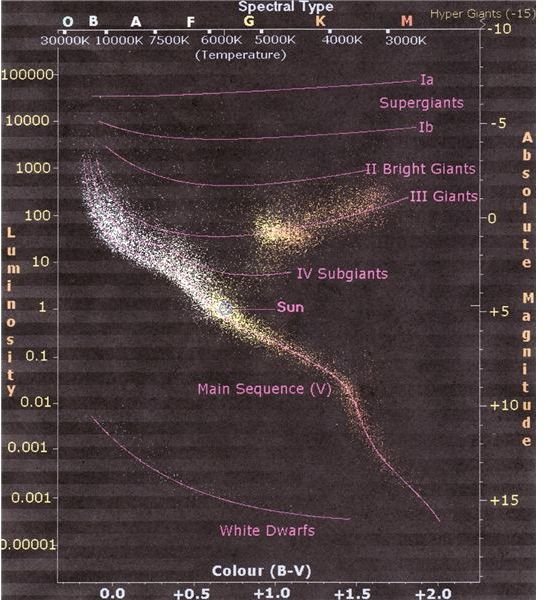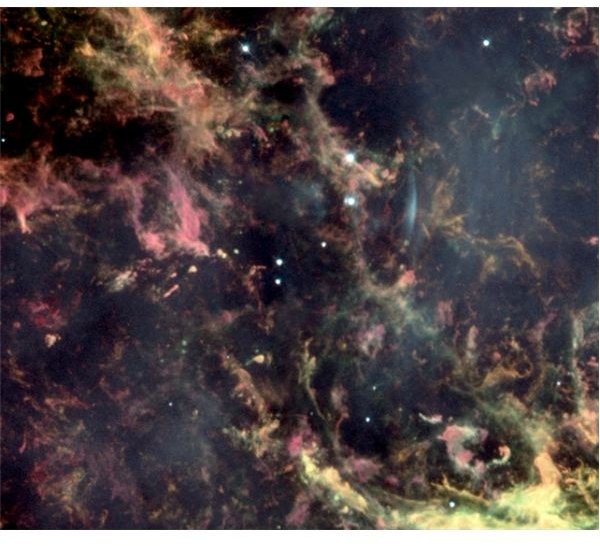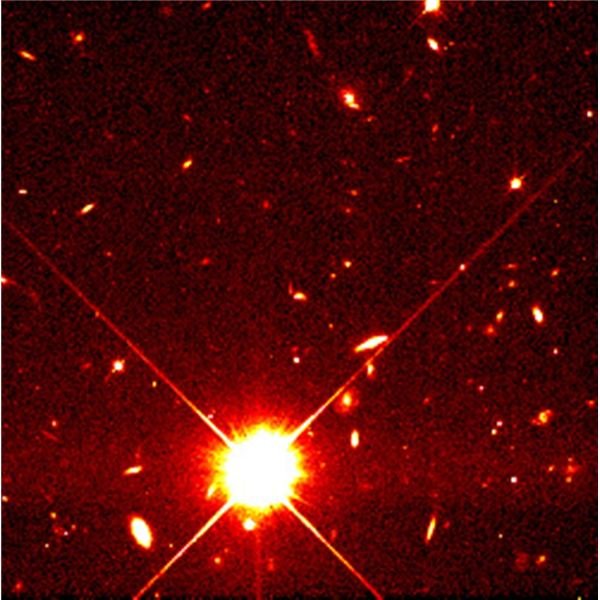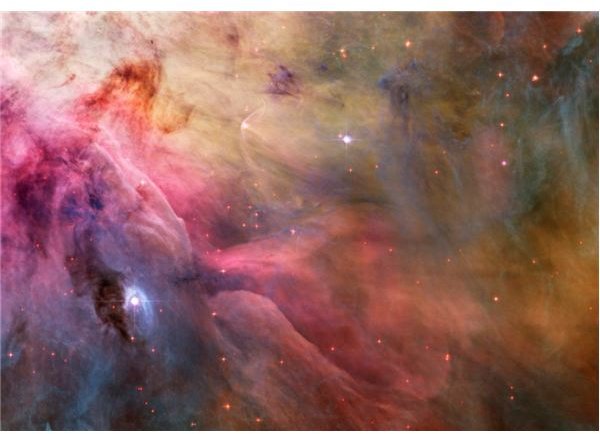How Star Evolution Works: Birth, Life and Death of Stars
A Star is Born
Stars are born when a swirling cloud of hydrogen gas and interstellar dust begins to coalesce into a distinct sphere. As the sphere grows, gravity compresses it more and more, and the temperature at the center rises. At some point, the gas and dust become compressed in the center to the point that the temperature is high enough to cause fusion to begin. A new star is born.
During this formative time, much more is going on. As the gas and dust coalesces, its central region begins to trap radiation so the temperature and pressure increases. A star with a mass about that of our sun, at this stage, will be much larger than the Sun, and as much as 1000 times brighter. But its temperature will be much lower than it eventually will be, as its heat at this point is supplied solely by gravitational contraction. However, it is producing light, and so is a protostar.
As the protostar continues to contract, the temperature and pressure at the core continues to increase until fusion begins. Temperatures increase further, and the core pressures increase to the point that they balance the gravitational contraction that has been pulling the gases toward the core. At this point the star is in hydrostatic equilibrium and is a full fledged star.
The basic fusion equation at work here is 2H+3H—>4He + 1n + energy, where n is a neutron.
This birth sequence holds true for stars of any mass above 0.08 solar masses, even giants many times larger than the Sun. A protostar with a mass as low as 0.08 solar masses never achieves nuclear fusion. Its heat and dim luminosity is created solely by gravitational contraction. It has a short life as a brown dwarf. Over a few thousand years it gradually cools and goes dark.
If the luminosity of a star is graphed against its temperature, all stars in their hydrogen burning phase will clump together in a long meandering grouping known as the Main Sequence. In the graph, below, (known as a Hertzsprung-Russel diagram) smaller stars are at the bottom right, and larger stars fall at the upper left of the diagram. The Sun, a fairly mid-size star, falls just about in the middle of the Main Sequence.

Notice as well, as you move through the Sequence, the color of the stars change. The smaller stars are red. Stars about the size of the Sun and up to about four solar masses are yellow. Stars larger become blue. This of course is a function of temperature.
Hydrogen burning stars larger than the small red stars at the lower end of the graph burn for billions of years, remaining in the Main Sequence throughout this period. Our Sun is expected to continue to burn its hydrogen for 10 billion years.
But eventually, all the hydrogen in the core is used up, transformed into helium. Then the star transforms.
After Hydrogen is Gone
When the hydrogen in the core is exhausted, radiation pressure cannot balance gravity, so the star contracts—but only slightly. This is because there is still hydrogen in the outer layers of the star, and it begins fusion. But fusion in these layers causes them to expand. The star becomes a Red Giant. Our Sun will go through this transformation 10 billion years from now, expanding out beyond the orbit of Mars. All inner planets, including Earth, will be scorched.
Hopefully mankind will have colonized at least our arm of the Milky Way by then, and the species will have a new home.
As the outer layers burn their hydrogen, the helium produced migrates to the core. Eventually, the helium builds up to a point that gravitational pressures and temperatures in the core cause the helium to begin fusion. The new energy produced by the core makes it expand. This reduces the fusion of the outer layers, so the total energy output of the star is reduced. This causes the star to contract again.
An important point about the helium cycle is the elements it produces. In stars up to about four solar masses, helium fusion first produces neon, then that fuses to oxygen and carbon. The planetary nebula surrounding the remnants of these former stars is filled with these vital elements.
This phase of a star’s life is extremely volatile. In this stage, it moves to the section of the graph to the right of the Main Sequence. During this period, the star undergoes violent pulsations and loses mass by ejecting material through powerful stellar winds. Eventually it will eject all its outer layers to form a planetary nebula. The star itself has collapsed to a dense small core in which the temperature is high enough to cause carbon to fuse. The star is now about 0.6 solar masses and only about the size of the Earth. It has become a white dwarf. It will continue life in this guise for billions of years.

But this is just the evolution of stars up to about four solar masses. More massive stars have a more explosive evolutionary tale.
Creation of Heavy Elements
Stars more massive than 40 solar masses have very strong stellar winds, and lose mass so rapidly they can’t expand into red giants. If the remaining core is no more than 1.4 solar masses, the fusion process continues as in less massive stars, except that the temperature is sufficient to fuse some of the neon into magnesium. The star eventually becomes a white dwarf.
If the core is more than about 2.5 solar masses, the oxygen begins to fuse into sulfur and silicon. As the core continues to collapse, the temperature becomes high enough to break down any nucleus. This forms alpha particles that fuse with other nuclei to form aluminum and sodium. If the star is too massive to form a white dwarf but not sufficiently massive to maintain the conversion of neon to oxygen and magnesium, it will collapse completely and explode as a supernova.
In even more massive stars, the fusion process continues until it produces iron. At this point, more energy is consumed producing iron than is generated, and the core undergoes a sudden, catastrophic collapse that overcomes the forces keeping nuclei apart and forces the electrons in the matter into the protons to form neutrons. The star becomes a very dense sphere of neutrons with a thin outer layer of iron.
It is a neutron star. It is only about 10 km in radius, and the compressed matter of which it is composed weighs 1015 grams per cubic cm. In the Hubble photo below of the Crab Nebula (M1), the bottom of the two stars, which are in a vertical line, slightly above and right of center, is the neutron star.

With a Bang and a Whimper
If the star is even more massive, the collapse is even more catastrophic, and the remaining protons and electrons in the collapsing outer layers also are compressed into neutrons. For an astronomical moment, the star releases the energy created by this transformation as a burst of neutrinos. The neutrinos bombard the iron core and create elements heavier than iron, up to and possibly beyond uranium.
They also force the star into one final expansion—an explosive expansion. It becomes a supernova.

There are four types of supernova—1a,1b, 1c and II. 1a supernova are rare, as they are white dwarfs that cannot maintain their plasma outer layers. These usually are in a binary system and pull off material from their companion. In their explosion, they reach an absolute magnitude of -19.5. Compare this with the magnitude of Venus, the brightest object in the sky, at -4.6. (Note that the minus in front of the magnitude number indicates a brighter object.) 1b and 1c supernova are more massive stars that have run out of fuel at their centers and have previously lost all their outer layers due to strong stellar winds. Their absolute magnitude is about -15.
In type II supernova the process is the same as described above, but the neutron core is about 30 km in diameter. It pulsates in a series of collapses and rebounds until it explodes in one final burst. Some of the material often falls back and coalesces. In stars originally of about 20 solar masses, the resultant remnant is a neutron star. If the original star was more than 20 solar masses, the remnant is a black hole.
It is possible for even more massive stars to go supernova without collapsing to a black hole, but that is rare. Generally, they collapse directly to a black hole without going supernova.
Credits
Main Sequence graph: Wikipedia https://upload.wikipedia.org/wikipedia/commons/7/78/H-R_diagram_-edited-3.gif
All star photos: NASA Hubble site https://hubblesite.org/gallery/album/entire/
